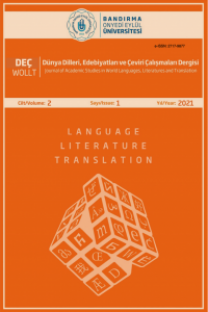The Story of the Shared Lives in the Double Life of Veronique
The idea of the doppelganger is a phenomenon that has been questioned in literature and film industry as well as in psychology. Krzysztof Kieslowski in his film, The Double Life of
Anahtar Kelimeler:
Doppelganger, corporeal and incorporeal, Kieslowski, Freud, the uncanny
The Story of the Shared Lives in the Double Life of Veronique
The idea of the doppelganger is a phenomenon that has been questioned in literature and film industry as well as in psychology. Krzysztof Kieslowski in his film, The Double Life of Veronique, discusses the dilemma of a double life of a person, and how two doubles affect each other. Polish Weronika and French Veronique, the two identical protagonists who are not aware of each other’s existence, share the same appearance and the same interests in life. Even their experiences in life draw a parallel between each other’s lives. Their corporeal relation affects and changes their life paths. Their life paths intermingle; the effect that opens an incorporeal possibility on their minds enlarges their understanding of both themselves and life. In the end, the question is; whose double life we witness or is it designed in a way that in case any damage is done, the other one takes the place, like a puppet which is created double in case of any damage? The parallel in Freud’s theory of the uncanny and in protagonists’ relationship in the film, on the psychoanalytical level, provides a better understanding of the emotions that Kieslowski builds up in the film, and makes the audience to consider their own experiences and emotions in life. From this point of view, the film presents us many possibilities, different perspectives on the subject of the possible shared lives of the protagonists with the uncanny connection between them.
Keywords:
Doppelganger, corporeal and incorporeal, Kieslowski, Freud, the uncanny,
___
- Derry, J. (2010). Incorporeal Encounters and Affective Relationality in Krzysztof Kieslowski’s The Double Life of Véronique. Intersections 2010: "Encounters: Situating 'Relation' in Communication and Culture (Vol. 9).
- Freud, S. (2003). The Uncanny (D. McLintock, Trans.; H. Haughton, Ed.). New York: Penguin Books.
- Haltof, M. (2012). The Cinema of Krzysztof Kieslowski: Variations on Destiny and Chance. New York: Columbia University Press.
- Hoffmann, E. (1982). Tales of Hoffmann (R. J. Hollingdale, Trans.). Harmondsworth: Penguin Books.
- Hoppe, K. (1964). Psychoanalytic Remarks on Schnitzler's "Fräulein Else". Journal of the International Arthur Schnitzler Research Association, 3(1), 4-8. doi:10.2307/45275152
- Kickasola, J. G. (2009). Kieślowski Crosses the Atlantic. In S.Woodward (Ed.), After Kieslowski: The Legacy of Krzysztof Kieslowski (pp. 165-185). Detroit, MI: Wayne State University Press.
- Kupper, H. I., & Rollman-Branch, H. S. (1959). Freud and Schnitzler-(doppelgänger). Journal of the American Psychoanalytic Association, 7(1), 109-126. doi:10.1177/000306515900700105
- Lacan, J. (2005). Ecrits (B. Fink, Trans.). New York: W. W. Norton
- Santilli, P. C. (2006). Cinema and Subjectivity in Krzysztof Kieslowski. The Journal of Aesthetics and Art Criticism, 64(1), 147–156. doi: 10.1111/j.0021-8529.2006.00236.x
- Schnitzler, A. (1998). Fraulein Else (F. H. Lyon, Trans.). London: Pushkin Press.
- Stok, D. (1993). Kieslowski on Kieslowski. London: Faber and Faber
- Yayın Aralığı: Yılda 2 Sayı
- Başlangıç: 2020
- Yayıncı: Bandırma Onyedi Eylül Üniversitesi
